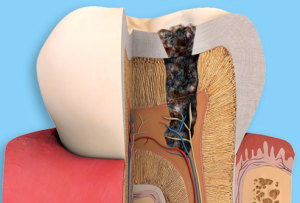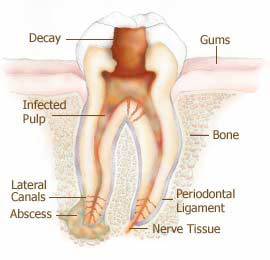By Arthur Kezian
An understanding on how cavities form in your teeth and the dangers associated with them is an important step in understanding your overall oral health. Preventive dentistry can catch early tooth decay before symptoms occur. Dr. Kezian and his staff are dedicated to detecting dental cavities early before too much damage is done to your teeth, that’s why dental check-ups are so important. They use innovative technology that allows early detection and conservative treatments.
What Is Tooth Decay?
 Tooth decay simply means the destruction of your tooth structure. This usually occurs when you eat foods containing carbohydrates like bread, fruits and even candy. Bacteria that normally reside in your mouth digest the carbohydrates into acids. The acids and leftover food particles combine to form plaque that stick to the enamel or outside layer of your teeth. The acids keep working and eventually eat through the enamel and begin to attack the dentin or inner layer of your teeth. Once this happens, you have a cavity.
Tooth decay simply means the destruction of your tooth structure. This usually occurs when you eat foods containing carbohydrates like bread, fruits and even candy. Bacteria that normally reside in your mouth digest the carbohydrates into acids. The acids and leftover food particles combine to form plaque that stick to the enamel or outside layer of your teeth. The acids keep working and eventually eat through the enamel and begin to attack the dentin or inner layer of your teeth. Once this happens, you have a cavity.
Tooth Decay Unchecked—a Real Danger
 What happens if tooth decay is not stopped? A cavity can continue to grow through the tooth layers, through the enamel and dentin, right into the tooth pulp. The tooth pulp is the living part of the tooth with nerves and blood vessels. Once this occurs, simple acts of chewing can result in significant pain and discomfort.
What happens if tooth decay is not stopped? A cavity can continue to grow through the tooth layers, through the enamel and dentin, right into the tooth pulp. The tooth pulp is the living part of the tooth with nerves and blood vessels. Once this occurs, simple acts of chewing can result in significant pain and discomfort.
Early Detection
Plaque build-up and early tooth decay often do not cause significant symptoms and, unfortunately, may go unnoticed. This is why preventive dentistry is so important. Routine dental check-ups are essential. Typically, a metal probe is used to seek out soft areas on your teeth. A soft spot represents an area of tooth decay. X-rays are taken to look for cavities that are hard to see, but once a cavity is seen on an X-ray, the lesion is usually advanced. Dr. Kezian and his staff use innovative technology during routine dental check-ups in order to identify early signs of tooth decay before it is too late. One example is DIAGNOdent, a handheld laser device that uses fluorescent light to detect dental cavities that are difficult to see with the naked eye. Early detection of tooth decay often allows for conservative, less painful treatments.
Routine brushing, flossing, and rinsing with mouthwash are what you can do at home to prevent bacterial overgrowth and plaque build-up. Combine that with routine dental check-ups, and you are well on your way to great oral health.
Dr. Arthur A. Kezian DDS 443 N. Larchmont Blvd Los Angeles, CA 90004 (323) 467-2777
